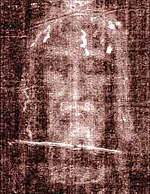Seconda Pia
Shroud of Turin – Photograph
Shroud of Turin
Secondo Pia‘s negative of his photograph of the Shroud of Turin
The Shroud of Turin (or Turin Shroud) is a linen cloth bearing the hidden image of a man who appears to have been physically traumatized in a manner consistent with crucifixion. The image is clearly visible as a photographic negative, as was first observed in 1898 on the reverse photographic plate when amateur photographer Secondo Pia was unexpectedly allowed to photograph it. The shroud is kept in the royal chapel of the Cathedral of Saint John the Baptist in Turin, Italy. The Roman Catholic Church has approved this image in association with the devotion to the Holy Face of Jesus and some believe it is the cloth that covered Jesus at burial. The shroud’s linen has been carbon dated and showed a date originating in the late 13th or early 14th century CE.[19] The shroud is thus a medieval hoax or forgery–or an icon created as such. It is the subject of intense debate among some scientists, believers, historians, and writers regarding where, when, and how the shroud and its images were created.
Source: http://www.gpedia.com/en/gpedia/Acheiropoieta
Gpedia is a free online encyclopedia. Our readers have access to over 5 million articles in English and altogether over 40 million articles in over 200 languages. All the articles are sourced from Wikipedia ™ and are free to copy and distribute under the creative commons license 4.0
If you like this blog, please link to it or share the link with others. Thank you.
